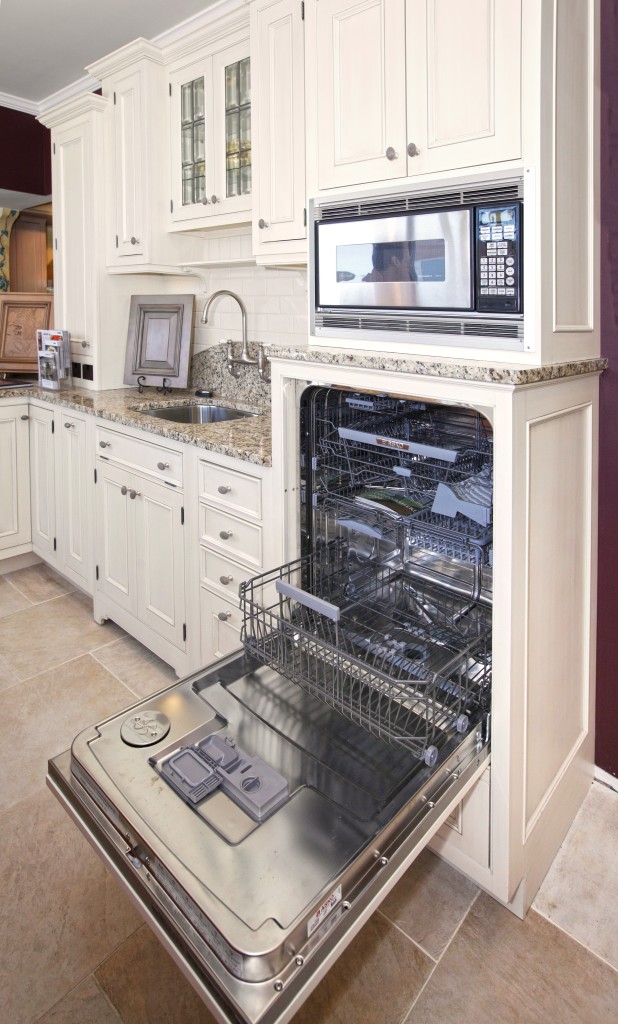Q: How much will it cost to remodel my kitchen or bathroom?
A: This is a much asked question, and an exceptionally difficult one to answer. The price for a new kitchen or bathroom will be affected by (1) where you buy it (2) what features it includes and (3) the brands / models you select.
 According to a survey by the National Kitchen and Bath Association (NKBA), the average selling price for a kitchen is around $26,000, including design, products and installation. The average kitchen selling price reflects average cabinets, appliances, an average sized room (falling within the 150 – 300 square foot range). Bathroom prices generally average between $6,500 and $11,600 when you’re replacing everything. Again, the cost can be lower or considerably higher depending on what you’re looking for.
According to a survey by the National Kitchen and Bath Association (NKBA), the average selling price for a kitchen is around $26,000, including design, products and installation. The average kitchen selling price reflects average cabinets, appliances, an average sized room (falling within the 150 – 300 square foot range). Bathroom prices generally average between $6,500 and $11,600 when you’re replacing everything. Again, the cost can be lower or considerably higher depending on what you’re looking for.
It is not unusual today for a kitchen to run from $30,000 to as much as $150,000 and higher. This may come as a shock to people who are living in a home they paid less than $100,000 for thirty years ago! However, for many people a new kitchen is a once-in-a-lifetime purchase. Eventually, if you sell your home, you can realize much of your cost, and possibly all of it. When you consider this, it makes the expense a little easier to live with.
Q: What makes a kitchen more or less expensive?
A: Cabinets account for about one-third to one-half the total cost of the project and will have the greatest impact on your budget. They range in price considerably based on quality, the type of material they are made of, and whether they are stock (ready made in specific sizes) or custom (produced specifically for your kitchen in whatever sizes and finishes are needed).
The material you choose for surfaces including counters, backsplashes and floors can also account for variations in price.
Other key elements that factor in to the equation are talent and workmanship. In the remodeling business, you tend to get what you pay for. An accomplished designer, skilled sub-tradesmen and expert installation crew may cost more. But you’ll appreciate their ability every time you use your kitchen.
Q: What makes a bathroom remodeling more or less expensive?
A: No single element of a bathroom remodel comprises a significantly larger portion of the costs than other elements. The type and quality of cabinets you select will affect your total costs.
Not surprisingly, fixtures and fittings account for a high cost percentage in the bathroom. Expense for fixtures and fittings will vary depending on the brand, type of materials, and array of products you select.
In bathrooms, installation typically accounts for a quarter or more of the total cost. This is because the installation work in a bathroom tends to be intricate (for example, tile setting). If you’re looking to cut corners, this is probably not the place to do it.
Q: Can I save money by cutting a few corners?
A: Yes, but chances are you’ll be disappointed when it’s done. Postponing some things is a better way to save than cutting quality. Put your money into the best quality products your budget can afford, even if you have to limit the number of products that you buy.
Q: Should I select my appliances first and then call in a kitchen planner?
A: This is not recommended. A kitchen design is much like a jigsaw puzzle, where each piece must fit into the whole design. By all means, research your appliance choices and formulate your “wish list,” but it is usually better not to purchase your appliances until the design has been finalized.
Q: Can I get other bids on the final design?
A: Our policy is to not release the plans, which are protected by copyright, until a purchase agreement has been made. In any event, it is extremely difficult to comparison shop for a kitchen, because different firms feature different products. Most of the time you will end up comparing “apples and oranges.”
If a company has been in business for some time, it’s usually a sign that their prices are competitive or they wouldn’t have stayed in business. Also, it’s more important to work with someone you feel comfortable with and trust than to try to save money with someone who implies they can save you “X amount of dollars.”
Q: What can I do myself to help cut costs?
A: How much you can or should attempt to do depends on your ability and knowledge of remodeling. You’ll definitely be able to tear out old cabinets (be careful not to damage walls and beams), take up old vinyl flooring and handle trash removal. You may also want to paint or wallpaper on your own. You’re better off letting the pros handle plumbing and appliance hook-ups – if you try it on your own, you may violate building codes or invalidate manufacturer warranties. And let a professional installer put your new cabinets in so that they look their best.
Q: How long should it take from showroom visit to finished kitchen?
A: It can take several months, even after the design is finalized. Custom cabinets usually take around eight to ten weeks for delivery. The extent of the job, the contractor’s workload and the availability of materials also have an effect. Once the materials have been delivered, installation can often be completed in as little as two to three weeks.
Q: Who’s the best person for the job?
A: There are a lot of professionals out there – interior designers, architects, remodeling contractors – but your best bet is to pick a designer or firm that specializes in the kitchen and bath area. There are thousands of companies that offer kitchen/bath design and installation services – many of them belong to the National Kitchen & Bath Association. There are also a select number of individuals certified by NKBA as Certified Kitchen Designers (CKD) and/or Certified Bathroom Designers (CBD).
 You’ll probably meet first at his office or showroom to share your ideas and basic needs. Then he’ll come to your home to take careful measurements of the space, make note of plumbing and structural elements, and get a feel for your home’s style. He’ll also ask a lot of questions about your kitchen or bathroom, lifestyle and family. He’ll be listening carefully so that the finished room you work to create reflects your personal taste and how you use the space. You’ll choose products, colors and materials together, working within your budget. The relationship can go only as far as creating your design, or you may have the design professional act as a consultant, or he may manage the entire project for you – including hiring sub-contractors and scheduling the work and supervising the installation.
You’ll probably meet first at his office or showroom to share your ideas and basic needs. Then he’ll come to your home to take careful measurements of the space, make note of plumbing and structural elements, and get a feel for your home’s style. He’ll also ask a lot of questions about your kitchen or bathroom, lifestyle and family. He’ll be listening carefully so that the finished room you work to create reflects your personal taste and how you use the space. You’ll choose products, colors and materials together, working within your budget. The relationship can go only as far as creating your design, or you may have the design professional act as a consultant, or he may manage the entire project for you – including hiring sub-contractors and scheduling the work and supervising the installation.
Q: What is a CKD?
A: A Certified Kitchen Designer (CKD) is a professional, qualified by education and experience to research, design, plan and supervise the installation of residential kitchens. Only after a rigid examination conducted by the National Kitchen and Bath Association, has he or she been awarded the CKD title. Use of this professional certification mark and seal is protected by law.
The CKD title identifies the exceptional qualifications of the competent Kitchen Specialist. It is public proof of responsible performance and professional skill.
Q: What about contracts and orders?
A: Before any work begins on your kitchen or bathroom, get detailed, written estimates, project specifications and signed contracts from the professionals you hire. Make sure they’re bonded and insured. (If you work with an NKBA member, he/she will likely coordinate all of your sub-contractors for you.) Check references carefully. Your designer should prepare project drawings including floor plans and renderings that clearly represent your project. If anything changes mid-project, you should be asked to sign a change order.
Q: What about payment?
A: Most firms will require a percentage (usually 50 percent or so) when you sign the contract, additional payment (usually 40 percent or so) when cabinets are delivered or installation begins, and the balance (10 percent or so) when the job is complete. You may also be required to pay a design retainer at the start of the job.
